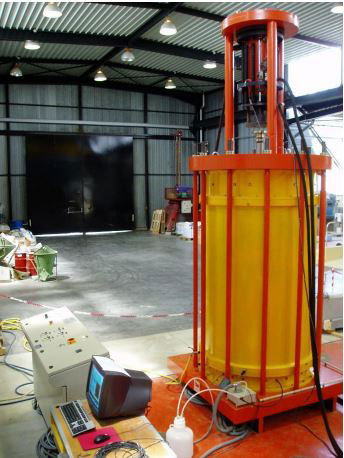Scale Transition Problems in Granular Materials
Ecole Centrale of Nantes, France
Problems
Granular media cover a large variety of materials, marked by differences in grain size (from a few micrometers in clays to a few meters in rockfills), grain shape, roundness and strength, as well as by differing grain evolution capabilities under external actions (cementation, breakage, chemical evolution, swelling, etc.). Predicting the macroscopic properties at the Representative Elementary Volume (REV) scale requires a full description of the geometry, the fabric and forces between grains, largely dependent on the grain dimension. Similarly, the design of geotechnical structures with granular materials in nonhomogeneous states of stress and strain involves challenging scale transition problems.
Approach
Our research activities are mainly concerned with the transition from the grain level to the REV level, from experimental and modeling vantage points, without excluding, however, the REV-to-structures transition issue. On the one hand, observations coming from the scanning electronic microscope, X-ray tomography and also destructive tests on individual grains, are designed to characterize the grain scale. These observations are then related to the stress - strain - strength relationship at the REV scale. In particular, a set of 3 triaxial cells (for samples of 70mm, 250mm and 1000mm, respectively) is employed to investigate the effect of grain breakage, whose amount is determined through grain size distributions (GSD) after loading, on the strength properties of dry frictional crushable soils (with maximum grain diameter of 12mm, 40mm and 160mm with regard to the respective sample size). On the other hand, from a numerical point of view, a homogenization procedure has been successfully developed to describe the initial state and the subsequent behavior of a collection of grains in contact. The basic equations representing the friction between grains have been gradually extended. An inter-granular adhesion has thus been implemented to simulate the response of grouted soils to mechanical loading. Similarly, capillarity forces at the grain level have been introduced to accurately represent the behavior of unsaturated soils. Reinforcing the role of Van der Walls-type surface forces vis-à-vis the gravity forces gives a satisfactory prediction of the behavior of lunar soils.

Findings
The statistical distribution of grain strengths with grain sizes has been combined with the distribution of local forces on grains using DEM models, and then introduced into a confined comminution model. It is therefore possible to predict the evolution of the grain size distribution with stress. This comminution model can be joined to any macroscopic constitutive model to account for the influence of grain breakage on the mechanical properties of granular materials. The micromechanical model was recently developed in order to account for the influence of internal erosion of fine particles due to water seepage through the granular matrix. Numerical simulations show the changes in mechanical behavior due to the removal of a solid fraction and the possible consequences on the stability of hydraulic works such as dams or dykes.
Impact
In collaboration with private companies involved in the design of geotechnical structures such as rockfills dams, the laboratory results are incorporated into the design rules to ensure their safety. Security factors on the friction angle taking into account the probability of breakage of large grains have been proposed. Similarly, the impact of internal erosion on various failure mechanisms has been analyzed.
Core competencies
- Mechanical behaviour of soils and granular materials;
- Size effects in granular soils;
- Micro-macro modeling using homogenization techniques;
- Large triaxial facilities.
Current research team members
- Pierre-Yves HICHER (Professor)
- Christophe DANO (Associate Professor)
- Jean-Pierre REGOIN (Engineer)
- Jean-Yves LE TOUZO (Engineer)
- Patrick DENAIN (Technician)
- Carlos OVALLE (PhD candidate)
- Gang LI (PhD candidate)


